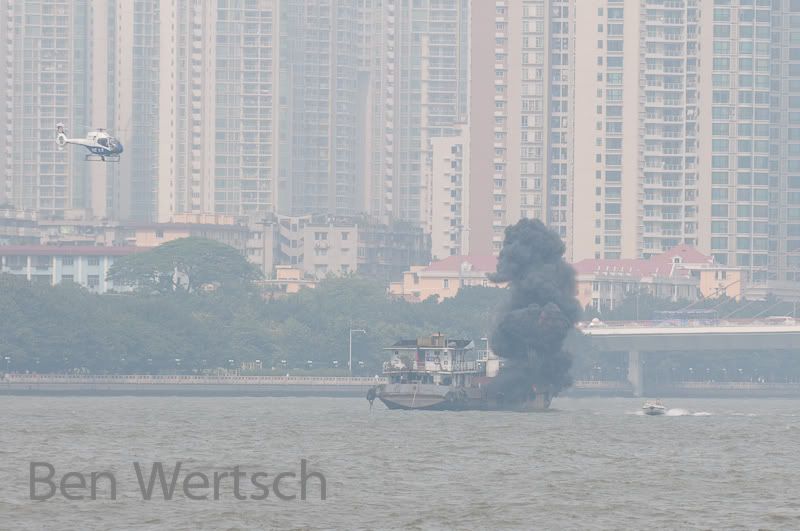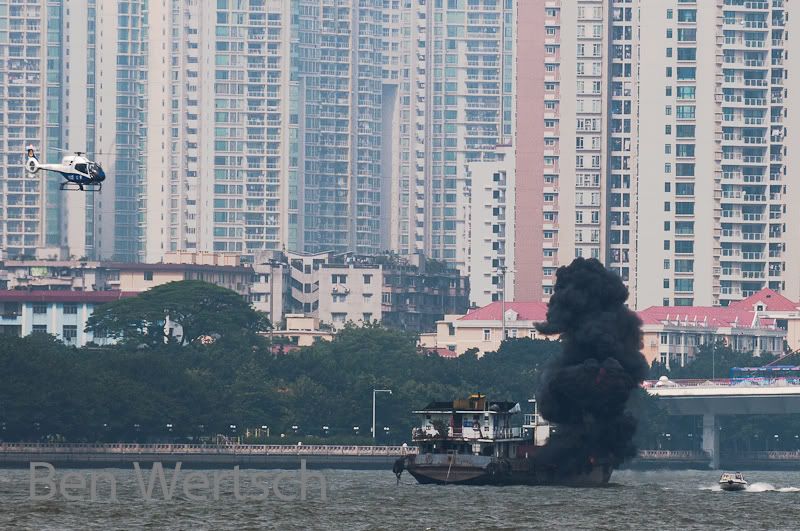Looking for black
Not sure if this is the right forum, or maybe it should be in finishing school.
Was shooting the other day in Guangzhou China. Here the skies are always blue and you can see for miles.
erm, actually, there aparently was this killer haze of smog and I've got two questions:
First, is it possible that my eyes can cut through the haze much better than the camera (d700 and D300) and nikons pro level glass can? I don't remember it being quite as hazy as my photos came out to be.
Secondly, what the heck do I do about this image, and its ugly step sisters?
This particular shot was taken with the Nikon D300 and 70-200 racked to 200. ISO 200 f5.6 1/100th of a second.
I'm including two versions of the image. 1 is straight out of the camera, as loaded into Lightroom, then converted to JPG. Aside from Cropping, nothing else. Seems hazier than when I shot the image, but as both my 14 bit RAW D700 and the 12bit RAW 300 have similar results, I'm not blaming the camera here. The LR3 Historgram has everything bunched up really close, slightly to the right.

Next up. . ..
Granted, this may not be the best PP work the world has ever seen, but I wanted to put some blacks back into the image. There was some serious surgery, the patient almost died several times, but here's what I ended up doing:
(note, I didn't adjust the sliders in this order, and had to go back and forth to make changes several times. Listing them in order here to make things easier to follow)
Exposure +1.43
Recovery +18
Blacks 82
Brightness -2
Contrast -31
Vibrance -17
Tone curve: some sort of weird custom curve. It looks. . . sinister.

So, what do you think? Did my heavy PP improve things or did I miss the mark? Can you do better? (know you only have the JPG here to work with, but if you really want to work it, I could probably email you the RAW original.)
And most iimportantly, how do I fix this problem while shooting in the future? Is it something that I can do in camera or will it require PP as with the above?
Oh and since I'm sure someone is asking, no I have no idea what was going on. But there were about 50 police boats, two helicopters, and a fire boat that roared up, then the explosion, then everyone went home. It was bizzarre.:scratch
Just thought of this, I might need to go out and really scour the protective filters on my lenses. I'm wondering if they were a bit dirty at the time. But carry on please.
Was shooting the other day in Guangzhou China. Here the skies are always blue and you can see for miles.
erm, actually, there aparently was this killer haze of smog and I've got two questions:
First, is it possible that my eyes can cut through the haze much better than the camera (d700 and D300) and nikons pro level glass can? I don't remember it being quite as hazy as my photos came out to be.
Secondly, what the heck do I do about this image, and its ugly step sisters?
This particular shot was taken with the Nikon D300 and 70-200 racked to 200. ISO 200 f5.6 1/100th of a second.
I'm including two versions of the image. 1 is straight out of the camera, as loaded into Lightroom, then converted to JPG. Aside from Cropping, nothing else. Seems hazier than when I shot the image, but as both my 14 bit RAW D700 and the 12bit RAW 300 have similar results, I'm not blaming the camera here. The LR3 Historgram has everything bunched up really close, slightly to the right.

Next up. . ..
Granted, this may not be the best PP work the world has ever seen, but I wanted to put some blacks back into the image. There was some serious surgery, the patient almost died several times, but here's what I ended up doing:
(note, I didn't adjust the sliders in this order, and had to go back and forth to make changes several times. Listing them in order here to make things easier to follow)
Exposure +1.43
Recovery +18
Blacks 82
Brightness -2
Contrast -31
Vibrance -17
Tone curve: some sort of weird custom curve. It looks. . . sinister.

So, what do you think? Did my heavy PP improve things or did I miss the mark? Can you do better? (know you only have the JPG here to work with, but if you really want to work it, I could probably email you the RAW original.)
And most iimportantly, how do I fix this problem while shooting in the future? Is it something that I can do in camera or will it require PP as with the above?
Oh and since I'm sure someone is asking, no I have no idea what was going on. But there were about 50 police boats, two helicopters, and a fire boat that roared up, then the explosion, then everyone went home. It was bizzarre.:scratch
Just thought of this, I might need to go out and really scour the protective filters on my lenses. I'm wondering if they were a bit dirty at the time. But carry on please.
0
Comments
Natural selection is responsible for every living thing that exists.
D3s, D500, D5300, and way more glass than the wife knows about.
Well, I yelled out "GUN CONTROL" but nobody took up sides. That was all I had with me and it didn't work I guess.
......a really high dollar Haze filer might help some......but that is a lot of smog...
I am surprized your eyes were not burning..........................................Mr. I. Disaster..................
Well my lungs sometimes do when I walk near the busier roads.
So, anything I can do at the time to help cut down some of this haze? Swear it looked better to my nekkid eye.
"It is important to distinguish between UV-generated haze and that of air-borne particles, such as smog. The latter is made up of opaque matter that absorbs visible light as well as UV, and will not be appreciably removed by a UV filter."
Probably will not really help in my situation. ANything else? What about my PP work? Look ok?
I think your post-processing improved the image a bunch. Given what you have to work with, I suggest you leave the global adjustments behind at this point and tweak specific colors for punching up by using "replace color." That way you can control the color range selection through "fuzziness" and adjust HSL to bring more life into specific parts of the image.
Very powerful and useful tool.
You mean it looked clearer to your nekkid eye? That is normal.
My understanding is, the way I look at it, recovery slider is to pull back highlights that are clipped. The black slider is for blacks that are to light. Brightness slider is to recover shadows that are clipped. Global contrast slidder is not good for much. Working with a raw image, its always good to apply vibrance (acording to Scott Kelby anyway)
Anyway, the main issue, when you look at the histogram, you will notice all the tones are towards the middle, and no tones even stretch close to the shadows. So if you go to your curve, you want to adjust the curve so the mountain on the histogram reaches both ends of the histogram.
The image was over exposed to begin with, so I would start by dropping the exposure before you adjust the curve. With the curve, your going to need to adjust the lights into the +70 range, and darks and shadows into the -70 range till you get a more normal looking histogram. Then adjust the blacks acording to what looks good and up the temp to what you like.
Thats how I would do it anyway
Most of the editing involved curves to boost contrast. But I also added some warmth (with the Photoshop warming filter). This really helps because haze is almost always heavy in the blues and taking them down will usually help quite a bit. In other images I've done this selectively (typically along the horizon). There's also a touch of local contrast enhancement and sharpening.
Still not great but a significant improvement on the original capture I think.
[Edit: By the way, I also pumped the vibrance, but I also reduced the saturation to compensate and avoid things going radioactive]
I had a go on ACDSEE PRO 2.5 with the Light Equalizer - Light EQ settings.
I had the same problem when I was in HK I dropped the fstop by 1 or 2 to get better results.
Mike
Thanks. A bit over saturated for my tastes but like the rich blacks. Probably the smoke looks better with a bit more grey thrown in though.I'm guessing you used levels and possilby curves. Is this correct? What else did you do?
Interesting. Your image's overall saturation looks fairly balanced. Does anyone have an answer about Saturation vs Vibrance? I was under the impression that vibrance was sort of a "saturation balancer" and also protected skin tones. Thus, I dialed DOWN vibrance, but never touched the saturation.
Thanks for your time I have learned a couple of new techniques in this thread.
An interesting edit. Looks very different than the others.
So, you drop F stop but increase shutter speed or do you decrease overal exposure?
I might have slightly overexposed my image but I figured that with the overal haze and sky, the meter might have wished to underexpose the scene.
The haze works for this shot.
Unfortunately, I was quite far away when the explosion went off.
I'm guessing this was some sort of training exercise, and the explosion was some FX thing. In another shot, I can see a man about to rappell out of a helicopter but as it was so far away, at the time I thought it was a camera man!
Vibrance increases saturation but rather gently. It also introduces a wider variety of color (versus simply boosting the colors that are already there).
If you crank up the vibrance and lower the saturation to compensate, it frequently produces a nice effect with rich color (but not so much that it starts to appear unrealistic).
Taking down the blue can really help with haze. Don't expect to eliminate it completely but you can certainly make it less objectional. Make that selective if you need to protect other colors/areas within the image.
YIKES! I looked at this on my calibrated monitor and yes, it is way to saturated for my taste too. I took another 5 min today using a calibrated monitor. Started by duplicating the image with a color burn blend mode and then used levels. Applied some curves and adaptive exposure. It could still use some work but it is a little warmer and less saturated than my previous post.
Thanks for your take on the haze. I definately have learned some new ways to go about dealing with it as well as editing in general.